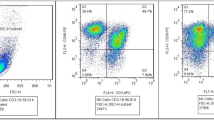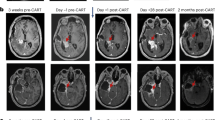Abstract
A prospective pilot study was performed in order to assess the safety of treating recurrent malignant gliomas (MGs) with locally infused autologous tumor infiltrating lymphocytes (TILs) and recombinant interleukin-2 (rIL-2). Six patients were entered between June 27, 1994 and June 2, 1995 and followed until July 1, 1998. At surgery an Ommaya reservoir was placed for later infusion of TILs and rIL-2. Following surgery, autologous TILs were expanded in vitro in the presence of rIL-2 and infused on treatment days 1 and 14, with concurrent rIL-2 infusions performed three times each week for one month. Following completion of immunotherapy all patients were offered chemotherapy. Phenotypic analysis demonstrated TILs to be T-lymphocytes (87–99% CD3+). Of these, 4 of 6 cases (67%) phenotyped as cytotoxic/suppressor T-lymphocytes (CD8+) and 2 of 6 cases (33%) phenotyped as helper/inducer T-lymphocytes (CD4+). TILs demonstrated limited selective cytotoxicity, with dose dependent cytotoxicity against autologous tumor, allogenic tumor and long term MG cell lines.
There were no significant (Grade 3 or 4) complications. One patient developed transient low grade fevers, and 2 developed asymptomatic hydrocephalus. All patients developed transient and asymptomatic cerebral swelling, noted on the immediate post-treatment imaging studies.
At three and six month follow-up, 3 patients responded with partial response, 2 demonstrated stable disease and 1 patient progressed. At long term follow-up, 1 patient had a complete response (45 month follow-up), 2 had a partial response (48 and 47 month follow-up) and 3 patients expired as a result of progressive disease (at 12, 12 and 18 months following immunotherapy). A relationship between subsequent chemotherapy or extent of resection to outcome was not appparent but could not be excluded.
This pilot study demonstrated that locally infused autologous TILs and rIL-2 could be delivered without serious toxicity. Further studies are indicated to determine the safety and long term efficacy of TIL immunotherapy.
Similar content being viewed by others
References
Ahmad I, Longenecker M, Samuel J, Allen TM: Antibodytargeted delivery of doxorubicin entrapped in sterily stabilized liposomes can eradicate lung cancer in mice. Cancer Res 53: 1484–1588, 1993
Akbasak A, Oldfield EH, Saris SC: Expression and modulation of major histocompatibility antigens on murine primary brain tumor in vitro. J Neurosurg 75: 922–929, 1991
Apuzzo MLJ, Mitchell MS: Immunological aspects of intrinsic glial tumors. J Neurosurg 55: 1–18, 1981
Arnold DL, Shoubridge EA, Villemure JG, Feindel W: Proton and phosporous magnetic resonance spectroscopy of human astrocytomas in vivo: preliminary observations on tumor grading, NMR Biomed 3: 184–189, 1990
Barba D, Saris SC, Holder CC, Rosenberg SA, Oldfield EH: Intratumoral LAK cell and interleukin-2 therapy of human gliomas. J Neurosurg 70: 175–180, 1989
Black PM: Brain tumors: Part 1. NEJM 324: 1555–1564, 1990
Boon T: Towards a genetic analysis of tumor rejection antigens. Adv Cancer Research 58: 179–210, 1992
Boring CC, Squires TS, Tong T: Cancer statistics, 1993. CA Cancer J Clin 43: 7–26, 1993
Brooks WH, Marksbery WR, Gupta GD et al.: Relationship of lymphocyte invasion and survival of brain tumor patients. Ann Neurol 4: 219–224, 1978
Chen S-H, Shine DH, Goodman CJ et al.: Gene therapy for brain tumors: regression of experimental gliomas by adenovirus-mediated gene transfer in vivo. Proc Natl Acad Sci 91: 3054–3057, 1994
Dan MD, Schlachta CM, Guy J et al.: Human antiglioma monoclonal antibodies from patients with astrocytic tumors. J Neurosurg 76: 660–669, 1992
Dick SJ, Macchi B, Papazoglou S et al.: Lymphoid cellglioma interaction enhances cell coat production by gliomas: novel suppressor mechanism. Science 220: 739–742, 1983
Figlin RA, Belldegrum A, Moldawer N et al.: Concomitant administration of recombinant human interleukin-2 and recombinant interferon alpha-2a: an active outpatient regimen in metastatic renal cell carcinoma. J Clin Oncol 10(3): 414–421, 1992
Gately MK, Glaser M, Dick SJ et al.: In vitro studies on the cell-mediated immune response to human brain tumors: 1. Requirement for third-party stimulator lymphocytes in the induction of cell-mediated cytotoxic response to allogenic cultured gliomas. J Natl Cancer Inst 69: 1245–1254, 1982
Guinan EC, Gribben JG, Boussiotis VA et al.: Pivotal role of the B7:CD28 pathway in transplantation tolerance and tumor immunity. Blood 84: 3261–3282, 1994
Hayes RL, Koslow M, Hiesiger EM et al.: Improved long term survival after intracavitary interleukin-2 and lymphokine-activated killer cells for adults with recurrent malignant gliomas. Cancer 76(5): 840–852, 1995
Holladay FP, Lopez G, De M, Morantz RA, Wood GW: Generation of cytotoxic immune responses against a rat glioma by in vivo priming and secondary in vitro stimulation with tumor cells. Neurosurg 30(4): 499–505, 1992
Jacobs SK, Wilson DJ, Kornblith PL et al.: Killing of human glioblastoma by interleukin-2 activated autologous lymphocytes. J Neurosurg 64: 114–117, 1986
Kawakami Y, Eliyahu S, Jennings C, Sakaguchi K, Kang X, Southwood S, Robbins PF, Sette A, Apella E, Rosenberg SA.: Recognition of multiple epitopes in the human melanoma antigen gp100 by tumor infiltrating T lymphocytes associated with in vivo tumor regression. J Immunol 154: 3961–3968, 1996
Kitahara T, Watanabe O, Yamaura A et al.: Establishment of interleukin-2 dependent cytotoxic T lymphocyte cell line specific for autologous brain tumor and its intracranial administration for therapy of the tumor. J Neuro-Oncol 4: 329–336, 1987
Kruse CA, Mitchell DH, Kleinschmidt-DeMasters et al.: Systematic chemotherapy combined with local adoptive immunotherapy cures rats with 9L gliosarcoma. J Neuro-Oncol 15: 97–112, 1993
Kugel H, Heindel W, Ernestus RI, Bunke J, du Mesnil R, Friedman G: Human brain tumors: spectral patterns detected with localized H-1 MR spectroscopy. Radiology 183: 701–709, 1992
La Salle GLG, Roberts JJ, Berrard S et al.: An adenovirus vector for gene therapy transfer into neurons and glia in the brain. Science 259: 988–1000, 1993
Mahaley MS Jr, Mettlin C, Natarajan N, Laws Jr, Peace BB: National survey on patterns of care for brain-tumor patients. J Neurosurg 71: 826–836, 1989
Merchant RE, Merchant LH, Cook SHS, McViciar DW, Young HF: Intralesional infusion of lymphokine-activated killer (LAK) cells and recombinant interleukin-2 (IL-2) for the treatment of patients with malignant brain tumor. Neurosurg 23: 725–731, 1988
Miescher S, Whiteside TL, de Tribolet N, von Fliedner V: In situ characterization, clonogenic potential and antitumor cytolytic activity of T-lymphocytes infiltrating human brain cancers. J Neurosurg 68: 438–448, 1988
Miyatake SI, Kikuchi H, Iwasaki K et al.: Specific cytotoxic activity of a T-lymphocyte clone derived from a patient with gliosarcoma. J Neurosurg 69: 751–759, 1988
Plautz GE, Barnette GH, Miller DW, Cohen BH, Prayson RA, Krauss JC, Luciono M, Kangisser DB, Shu S: Systemic T cell adoptive immunotherapy of malignant gliomas. J Neurosurg 89: 42–51, 1998
Quattrocchi KB, Miller CH, Wagner FC et al.: Cell-mediated immunity in several head injured patients: the role of suppressor lymphocytes and serum factors. J Neurosurg 77: 694–699, 1992
Quattrocchi KB, Lensley LL, Dull ST, Miller CH: Applicability of tumor-infiltrating lymphocytes in the treatment of malignant gliomas. American Association of Neurological Surgeons 1437 (Abstract): 280–281, 1995
Rosenberg SA: The adoptive immunotherapy of cancer using the transfer of activated lymphiod cells and interleukin-2. Semin Oncol 13: 200–206, 1986
Rosenberg SA, Packard BS, Aebersold PM et al.: Use of tumor infiltrating lymphocytes and interleukin-2 in the immunotherapy of patients with metastatic melanoma: a preliminary report. NEJM 319: 1676–1680, 1988
Rosenberg SA, Spiess P, Lafreniere R:Anewapproach to the adoptive immunotherapy of cancer with tumor-infiltrating lymphocytes. Science 233: 1318–1321, 1986
Salcman M: Epidemiology and factors affecting survival. In: Apuzzo MLJ (ed) Malignant cerebral glioma. American Association of Neurological Surgeons, Park Ridge, IL, 1990, pp. 95–110
Saris SC, Spiess P, Lieberman DM et al.: Treatment of murine brain tumors with systemic interleukin-2 and tumorinfiltrating lymphocytes. J Neurosurg 76: 513–519, 1992
Sawamura Y, Abe H, Aida T, Kobayashi H.: Isolation and in vitro growth of glioma infiltrating lymphocytes, and an analysis of their surface phenotypes. J Neurosurg 69: 745–750, 1988
Sawamura Y, Hosokawa M, Kupper MC et al.: Antitumor activity and surface phenotypes of human glioma-infiltrating lymphocytes after in vitro expansion in the presence of interleukin-2. Canc Res 49: 1843–1849, 1989
Shilyansky J, Nishimura MI, Yannelli JR et al.: T-cell receptor usage by melanoma-specific clonal and highly oligoclonal tumor infiltrating lymphocyte lines. Proc Natl Acad Sci 91: 2829–2933, 1994
SmithMM,Thompson JE, Castillo M, Cush S, Mukherji SK, Miller CH, Quattrocchi KB: MR of recurrent high grade astrocytomas after intralesional immunotherapy. AJNR 17: 1065–1071, 1996
Yoshizawa H, Chang AE, Shu S: Specific adoptive immunotherapy mediated by tumor-draining lymph node cells subsequently activated with anti-CD3 and IL-2. J Immunol 147: 729–737, 1991
Author information
Authors and Affiliations
Rights and permissions
About this article
Cite this article
Quattrocchi, K.B., Miller, C.H., Cush, S. et al. Pilot Study of Local Autologous Tumor Infiltrating Lymphocytes for the Treatment of Recurrent Malignant Gliomas. J Neurooncol 45, 141–157 (1999). https://doi.org/10.1023/A:1006293606710
Issue Date:
DOI: https://doi.org/10.1023/A:1006293606710




